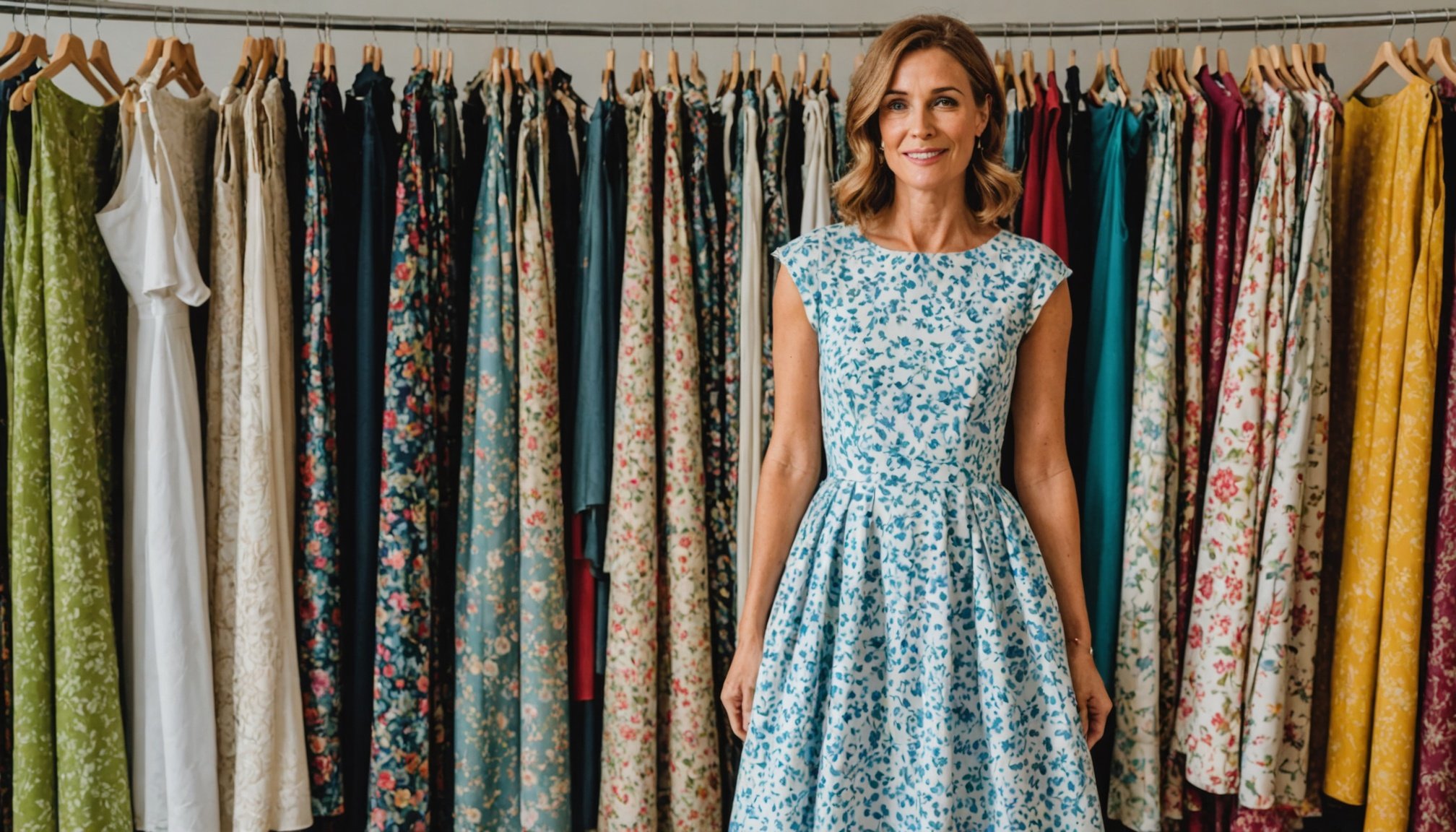Understanding Fabric Types for Handmade Dresses
When diving into dress-making fabrics, understanding the myriad of fabric types is pivotal. Various fabric materials each offer distinct characteristics, making some more suitable than others depending on the style and function of the dress.
Natural fabrics like cotton, linen, and silk are renowned for their breathability and comfort. They are ideal for casual or summer dresses that benefit from airflow and softness. In contrast, synthetic fabrics such as polyester, nylon, and rayon are praised for their durability and wrinkle resistance, making them excellent choices for structured or formal attire.
This might interest you : Step up your style: fun socks and more at our sock shop!
Natural vs Synthetic Fabrics
A key consideration in our fabric guide is comparing natural to synthetic options. Natural fabrics typically offer a more environmentally friendly option. They’re biodegradable and generally more breathable. However, their maintenance might be more demanding, requiring careful laundering. On the flip side, synthetic fabrics often boast convenience features like being machine washable and holding colours well, appealing to those preferring low-maintenance solutions.
Selecting the Right Fabric
Choosing the right fabric involves contemplating the dress’s desired purpose. For instance, flowy summer dresses might call for lightweight cotton, while a figure-hugging evening gown might benefit from the structured resilience of a synthetic blend. Always consider the fabric’s drape, weight, and texture alongside your dress-making aspirations.
Have you seen this : Explore the Top UK Online Retailers for Personalized Yoga Clothing Choices!
Properties of Fabrics and Their Suitability
When selecting fabrics for dresses, one must consider key fabric properties such as breathability, weight, and drape. These elements are essential for determining the suitability for dresses of different styles and ensuring comfort and ease of movement.
Breathable fabrics are ideal for casual wear and warm climates as they allow air to circulate, keeping the wearer cool. Cotton, linen, and rayon are popular choices due to their natural breathability. For evening dresses, fabrics like silk and satin offer a luxurious look and feel while still allowing some air circulation.
The weight of a fabric affects how it sits and moves on the body, making it a vital consideration for both casual and formal dresses. Lighter materials such as chiffon or tulle provide a more airy and gentle drape, perfect for flowing garments. In contrast, heavier fabrics like velvet or brocade offer structure and are favourable for more tailored styles.
Drape determines how fabric falls and conforms to the body’s shape, impacting the overall appearance of a dress. Ensuring a fabric’s suitability involves balancing these properties to achieve the desired aesthetic and fit for any occasion.
Sourcing Fabric in the UK
Navigating through UK fabric suppliers can be both exciting and overwhelming for dressmakers. The United Kingdom is home to a variety of fabric stores that cater to different styles and preferences. Popular physical stores like Liberty London and The Cloth House are renowned for their unique selections and high-quality materials. These stores provide a tangible experience, allowing customers to feel the fabric before purchasing.
For those who prefer online fabric shopping, platforms such as Fabric Godmother and Minerva crafts offer extensive collections that can be browsed from the comfort of home. These online marketplaces highlight textiles ranging from classic cottons to luxurious silks. They offer user-friendly interfaces that make the shopping experience straightforward and enjoyable.
Finding quality fabric doesn’t stop at stores. Exploring local markets and sales events can unveil hidden gems. London’s Borough Market and Birmingham’s Rag Market frequently host stalls brimming with diverse textiles. Attending these events can lead to discovering fabrics at competitive prices or even tipping off about future sales events, making them invaluable for budget-conscious creators.
Seasonal Trends in Fabric Selection
Navigating the vast realm of fabric selection can be exhilarating for both dressmakers and fashion enthusiasts. Each season brings its own charm and calls for particular materials and color palettes. Understanding these seasonal trends helps in crafting attires that reflect the current fashion ethos.
In the current fashion scene, lightweight materials like cotton and linen dominate the summer season. These fabrics allow for better air circulation, crucial for warmer climates. Conversely, winter calls for materials like wool and cashmere, offering both warmth and elegance. These fabric choices directly echo seasonal weather variations and their necessities.
When it comes to seasonal colors, spring often invites pastels like baby blue and blush pink, whereas autumn flaunts deeper shades of maroon and forest green. Staying updated with these nuances ensures outfits remain timely and stylish.
Another rising trend in fabric selection is the focus on sustainability. More designers are turning to eco-friendly textiles, such as organic cotton and bamboo fibers. This shift not only supports environmental responsibility but also caters to the growing demand for ethical fashion choices among consumers. By integrating sustainability, dressmakers can craft garments that resonate with eco-conscious buyers.
Practical Tips for Choosing Fabric
Choosing the right fabric for dress-making can transform your project from mundane to magnificent. Understanding fabric selection tips is essential to balance aesthetics with practicality. Start by considering the durability of the fabric. Durable fabrics, like denim or canvas, are ideal for garments that demand longevity. However, if elegance is your goal, fabrics like silk or chiffon may be your choice, though they’re more delicate.
Maintenance is another critical consideration. Fabrics that require special care, such as dry-cleaning, may not suit everyone’s lifestyle. Consider whether you’re willing to invest the time and resources into maintaining your garment. For everyday wear, washable fabrics like cotton or polyester can offer ease without sacrificing style.
Before purchasing, always test your fabric. Fabric testing techniques include the wrinkle or stretch test to assess quality. Scrunching a piece in your hand can reveal how prone it is to wrinkle, while a quick stretch test can show its elasticity and recovery. These simple tests can save you from fabric-related regrets.
Ultimately, combining aesthetics with these practical considerations will ensure your dress-making project is both beautiful and enduring.
Visual Examples of Fabric Choices
Choosing the right fabric for handmade dresses is crucial, as each fabric brings a unique texture and feel. This guide will help you compare and understand different fabrics through a photographic guide.
Start with viewing photographs of popular fabrics like cotton, silk, and linen. Each image can highlight its specific qualities, such as the smoothness of silk compared to the breathable texture of cotton. This visual fabric guide provides you a clear perspective on texture, weight, and drape, making it easier to make informed choices.
A dress fabric comparison can further assist you in deciding which fabric suits a specific dress style. For example, a thick wool blend might be better suited for a winter dress, while a light cotton is perfect for summer wear. Through comparative images, you can visually appreciate the differences in fabric weave and how this affects the dress appearance.
While images are a valuable starting point, consider expanding your exploration. Seek further education on fabric types to deepen your understanding. Engaging with this resourceful content gives you the confidence to select the best fabric for your handmade dress projects.











